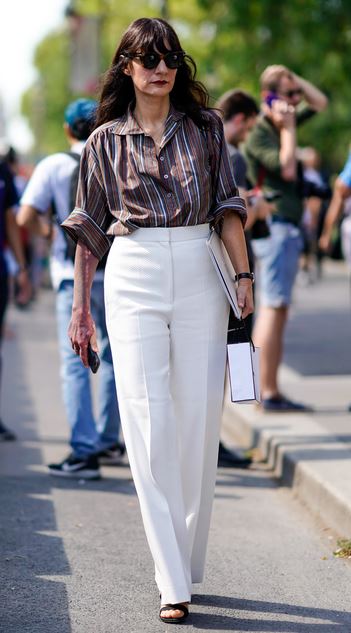Arguably the most elegant decade of the 20th century, the 1970s brought us everything from miniskirts to maxi dresses, flared trousers, wide-brimmed hats and more. 1970s essentials included flared and wide trousers, wedges, knitted vests, long-collared shirts, form-fitting T-shirts, turtlenecks, and lounge dresses, among many others.
The typical 1970s jumpsuit almost always featured flared legs and bell sleeves. Flared jeans and flared trousers of any shape were considered a staple of women’s fashion in the 1970s. Flared trousers and fitted shirts were all-70s classics that Boogie Wonderland supports, but there was so much more to 70s style than this look.
Knitted dresses without sleeves were worn over shirts with short or long sleeves with golfs in winter. Many winter dresses were button-down shirts with long sleeves and a matching belt. For most women, everyday fashion included wearing high-waisted wide-leg trousers in pastel-coloured cotton or polyester jersey, paired with a tunic, button-down blouse, or fitted jersey shirt.

This look included tight shirts or dresses with a fitted blazer with wide lapels, bell-bottoms, sweaters, cardigans, and boots. The simpler trends for women in the early 1970s included fitted blazers (available in a variety of fabrics with wide lapels), long and short dresses, miniskirts, maxi evening dresses, knickers (very short and tight shorts) paired with skinny pants. . T-shirts, suits for him and for her (virtually identical to each other) and flared trousers.
In 1973, dresses were more like the fashions of the 1940s and 1950s with A-line skirts or pleated skirts and button-down tops. The A-line mini dress, knit dress, low waist dress, and tunic dress were still fashionable clothing styles in the early 1970s. Simple one-piece dresses with a sash, cap sleeves and a flowing skirt, or a two-piece tunic blouse, skirt and tie waist, which made up the majority of everyday dresses of the seventies. While today’s maxi dresses tend to be sleeveless halter styles, 1970s maxi dresses were also popular with long and short sleeves, V-neck or tie.
Popular styles included flared trousers, fringed jeans, midi skirts, long dresses, ties, peasant blouses, and ponchos. More casual looks for men included flared jeans, tie-dye, flannel shirts, pleated trousers, and sweaters with oxfords, platforms, flip flops, or boots. Other dresses worn in women’s semi-formal wear include suede coats, boars, blazers, cowl neck sweaters, pencil skirts, backless dresses, extra low neck dresses, palazzo trousers, sheath dresses, evening dresses, jacket dresses and pinstripe suits. Womenswear in the 70s could be very glamorous in nightclubs with sequins, metallics, kaftans and skimpy dresses, but many opted for practical dance pieces like jumpsuits, flared trousers or palazzo trousers, which were trousers that flowed like a skirt.
In addition to disco styles, women’s fashion in the early 1970s became more relaxed. In addition, the early and mid-1970s were a time when women’s fashion became more accessible. While punk imagery was present in the late 1970s, in the mid-1970s men adopted the glam rock style. Men’s fashion in the early 1970s was heavily influenced by bright colors and textures.
For women, the hippie look of the 60s was carried over into the early 70s. In the mid-1970s, the hippie style fell out of fashion for both men and women, giving way to a more laid-back casual style. Hippie fashion began to develop in the late 1960s and reached its peak in the early 1970s, when elements such as flared trousers, tie-dye tops, headbands, embroidered folk patterns and flowing scarves became part of the traditional fashion. The glam rock look included several key styles such as tracksuits, satin shirts, velvet blazers, silk scarves, leather jackets, oversized collars, flared trousers, and platform shoes.
Common pieces include miniskirts, hippie-popular flares, retro dresses from the 1950s and earlier, and neutral rock and disco styles that introduce platform shoes, brights, sequins, and satin. Shoe styles are as diverse as clothing styles, but the main fashion trend of the 1970s was the platform sole, available in a variety of heights, colors and upper styles to match any outfit. Leather pants were one of the many problematic trends of the 1980s.

In fact, the 1970s was the first time in history that women started wearing trousers instead of dresses or skirts, especially in the workplace, as many women wore trousers with silk bow tops in the office. The ascot was back in mainstream fashion in the 1960s, but this time more popular with women wearing feminine and decorative scarves around their necks in a variety of ways.
While women don’t actually wear men’s ties, Ascot tie shirts are pretty much a way for them to show their style that they’re dressing for work. In the 1970s, everyone, men and women, celebrities and schoolgirls, wore geta. The 1970s may have been the first full decade when women in all walks of life wore pants.
Wedding dress fashions matched both evening and day wear of the 1970s, with some Holston-style jerseys being very form-fitting, but in general innocent ruffled prairie dresses and peasant styles were the most popular, often with lots of lace and high heels. collars, always white. Continuing the fashion theme of the individual style of the 60s, rockets, platforms, fringes and suede dominated the 70s with icons galore; Joni Mitchell, Cher, Bianca Jagger and many others made a splash in the style world. Go-go boots were still worn in the early years with mini dresses and skirts.